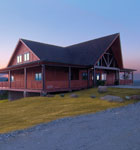At a Glance
Location
Phoenix, AZ
Founded
2010
Employees
8
Specialty
Environmentally sensitive hazardous- or catastrophic-disaster cleanup
Larry Howell’s eyes were glued to his television in Monroe, Washington. It was April 2010, and there had been a horrific explosion on a drilling rig just off the coast of Louisiana. He watched, as did millions around the world—but then he decided to do more than just watch.
“CNN had footage of relief workers leaning over johnboats, and they were literally using cloths to wipe off the reeds,” Howell remembers. “It was like a lightbulb going off.” Convinced that he could engineer a better solution to clean up the marshes than leaning over alligator-infested waters to blot foliage by hand, Howell took his vacation time from work and hightailed it south.
While there, he discovered a startlingly simple but unique method to wash the oil out of the marshland. Two weeks later, he turned in his resignation and founded KEBAWK Group, LLC—an engineering company named with the first initials of his six children: Kyle, Emily, Blake, Austin, Wyatt, and Kyleigh.
Howell was poised to bring a unique skill set to the recovery efforts. He had spent time in the US Navy working with dive units, and after more than two decades in the construction industry, he knew a thing or two about engineering. Applying his specific knowledge, Howell was able to answer the call to action, keeping KEBAWK on-hand to provide industry-leading oil companies with never-before-seen tools and solutions to help repair the damage done by one of history’s worst environmental disasters.
Top 3 Oil-Removal Tools Created by KEBAWK
1. The Marsh Flusher, simply put, is a shower. At the end of a long arm, a 20-foot wand with pressurized (up to 42 psi) streams forces oil off the blades of grass. Because the marsh is a complex ecosystem full of delicate nutrients, the Marsh Flusher avoids aiming at roots and instead consistently washes at a certain level.
2. The Shallow Water Skimmer’s (SWK) superiority lies in its ability to work effectively in as little as three inches of water. With a wide configuration of panels, the SWK acts as a vacuum to suck up oil as it sits on the water’s surface. In 12 hours, it can remove up to 46 barrels of a 70% oil, 30% water mix.
3. The Mobile Extended Reach Excavator (MERE) is the most versatile of KEBAWK’s offerings, acting as an extendable arm mounted on a barge. Five attachments are in its arsenal: the Adjustable Tine Rake, the Wrack Line Grapple, the Triple Blade Bower, the Hay Mower, and the Squeegee. The mechanism as a whole is designed for “near-shore application requiring a feather-like touch.”
It was KEBAWK’s Marsh Flusher that caught official attention and catapulted the company into high demand. Outfitted with a 20-foot wand on the end of a 39-meter boom, the Marsh Flusher sprays pressurized streams of brackish water from the Gulf. It acts almost as a comb of water, moving over the marsh to wash oil off the plants. “I thought, ‘Wow. We could just wash the marsh,’” Howell says. “And the first three people I told said, ‘You’re crazy.’”
At $57,000 a pop, Howell had to take some serious risk to put the first Marsh Flusher together. “It was scary,” he says. “I didn’t have that kind of money, but I went with my gut instinct. I knew it would work.”
Howell showed a 10-minute video of the Marsh Flusher in action to one of the section leaders for marsh cleanup. “Ten seconds in, he said, ‘I need three of these in the water right now,’” Howell recalls. In just under three weeks, he had them in the water. And after Howell jumped through the numerous regulatory hoops associated with such a wide-scale operation, he and his crew were soon putting in 18-hour days. Business took off. Over the next few months, KEBAWK combed miles of marshland, removing dead vegetation and squeegeeing oil.
The change was dramatic. “The grass had grown three feet by the time we left,” Howell says. “Everything was back to life; fisherman were out fishing. It felt like a job well done.”
It doesn’t end there, either. Following the aftermath, KEBAWK has been working with the Southwest Research Institute, exploring the idea of using the system on raging rivers for debris and rock removal. The company is also investigating opportunities with oil-eating microbes.
“We’re humbled,” Howell says. “But we know it wasn’t a one-hit wonder.” Moving forward, Howell won’t be watching idly. He’ll be preparing his company to swoop in at a moment’s notice when disaster strikes next. ABQ



